Learn to Do the Incline Barbell Bench Press For A More Complete Chest (original) (raw)
- How to Incline Barbell Bench Press
- |
- Variations
- |
- Alternatives
- |
- Who Should Incline Barbell Bench Press
- |
- Sets and Reps
- |
- Benefits
- |
- Muscles Worked
- |
- Common Mistakes
- |
- FAQs
The bench press is a chest day staple for a reason. It’s a beast of a lift that builds your chest, triceps, and shoulders; it even involves your back. Switching up your pressing angle with the incline barbell bench press shifts tension to your upper chest fibers and elicits more effort from your shoulders. Here, our certified strength training experts will take you through everything there is to know about this powerhouse chest exercise. Grab an adjustable weight bench and let’s get started.
Meet the Experts
This article was originally written by Mike Dewar, CSCS, weightlifter and strength & conditioning coach who founded J2FIT. Alex Polish is _BarBend_’s Editor, a certified personal trainer (through the American Council on Exercise), and is certified in Kettlebell Athletics.
Jake Dickson, _BarBend_’s Senior Writer, verified this article. Dickson holds a B.S. in Exercise Science, as well as a CPT-NASM certification and USAW-L2 weightlifting certification.
Editor’s Note: The content on BarBend is meant to be informative in nature, but it should not be taken as medical advice. When starting a new training regimen and/or diet, it is always a good idea to consult with a trusted medical professional. We are not a medical resource. The opinions and articles on this site are not intended for use as diagnosis, prevention, and/or treatment of health problems. They are not substitutes for consulting a qualified medical professional.
This step-by-step form and technique guide is for the incline bench press using a barbell. Most of the steps would be similar if you were to use dumbbells or a specialty bar.
Equipment Needed: You’ll need a barbell and weight plates, as well as an incline bench. This is much easier to set up if you have a set incline bench pressing station, but you can also roll an adjustable weight bench into a squat rack or power rack and set it up yourself.
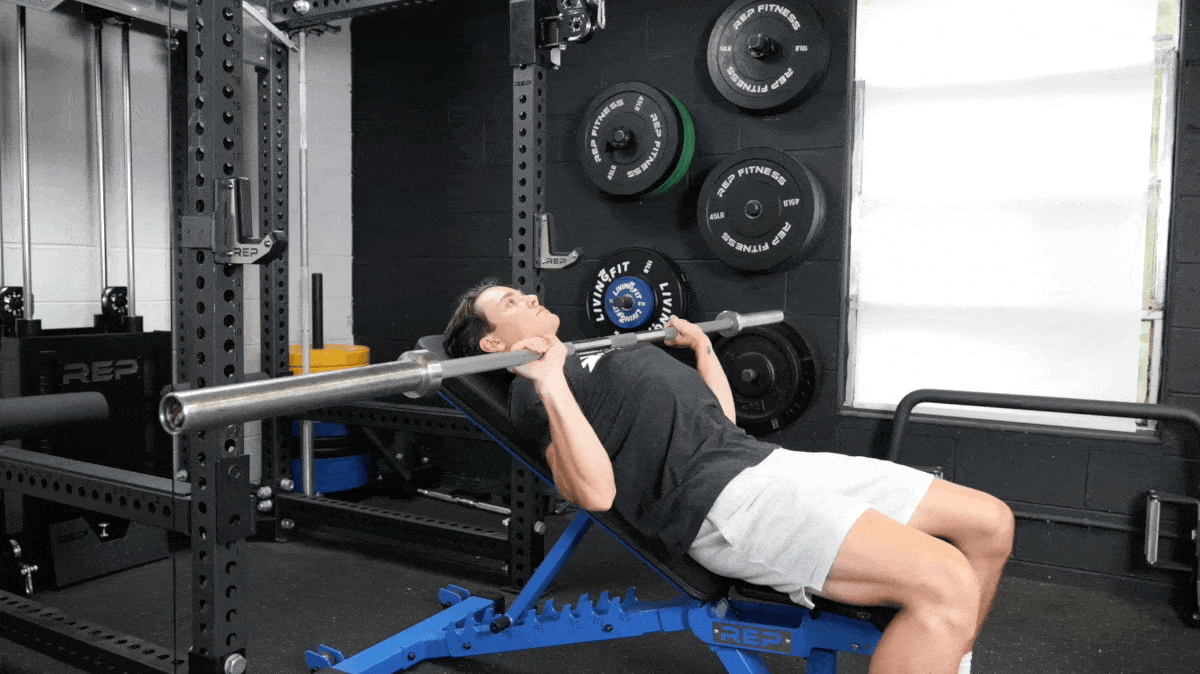
[Read More: Read Up on These 9 Proven Benefits of the Bench Press]
Make sure you can reach and unrack the bar with ease, and the bar should be able to descend comfortably to your upper chest after unracking. Avoid putting the bench too far back or too far forward: you want your shoulders and upper back to feel more or less like you’re unracking a regular flat bench press — strong and secure.
Experiment with the position of the bench as needed, using an empty barbell to test your position.
- Step 1 — Set up an incline workout bench to about 30 or 45 degrees. Load the bar. Lie back on the bench. Set your hips and upper back on the bench. Root your feet into the floor. Actively press your knees out.
- Step 2 — Where your hands sit on the bar comfortably is different for each person. But generally speaking, your hands may be slightly wider than shoulder-width. If you’re unsure, your forearms should be perpendicular to the ground at the bottom of the bench press. Too wide or too narrow of a grip width will result in your forearms angling outwards or inwards.
- Step 3 — Unrack the barbell. Stabilize it above your upper chest and shoulders. To do so, forcefully retract your shoulder blades and squeeze the barbell to better activate your grip. Pull the barbell to your chest. Actively use your back muscles to keep your chest and shoulders from rounding forward. As you lower the bar, actively stretch your pectoral muscles. Make sure to keep your shoulders on the bench.
- Step 4 — While pulling your elbows inward toward your body, press the bar upward. Extend your elbows. Be sure not to lose control or stability in this phase. Generally speaking, your elbows should not flare out. Keep your shoulders on the bench.
Coach’s Tip: Do not let the bar drop to your chest. Pull the bar towards your chest. Think of your lats as a spring that you’re loading up for more pushing force.
Incline Barbell Bench Press Variations
In the event you want to add some variety to your incline bench press training, you can incorporate dumbbells, unilateral pressing options, or simply change the speed at which you train with the barbell.
Incline Dumbbell Bench Press
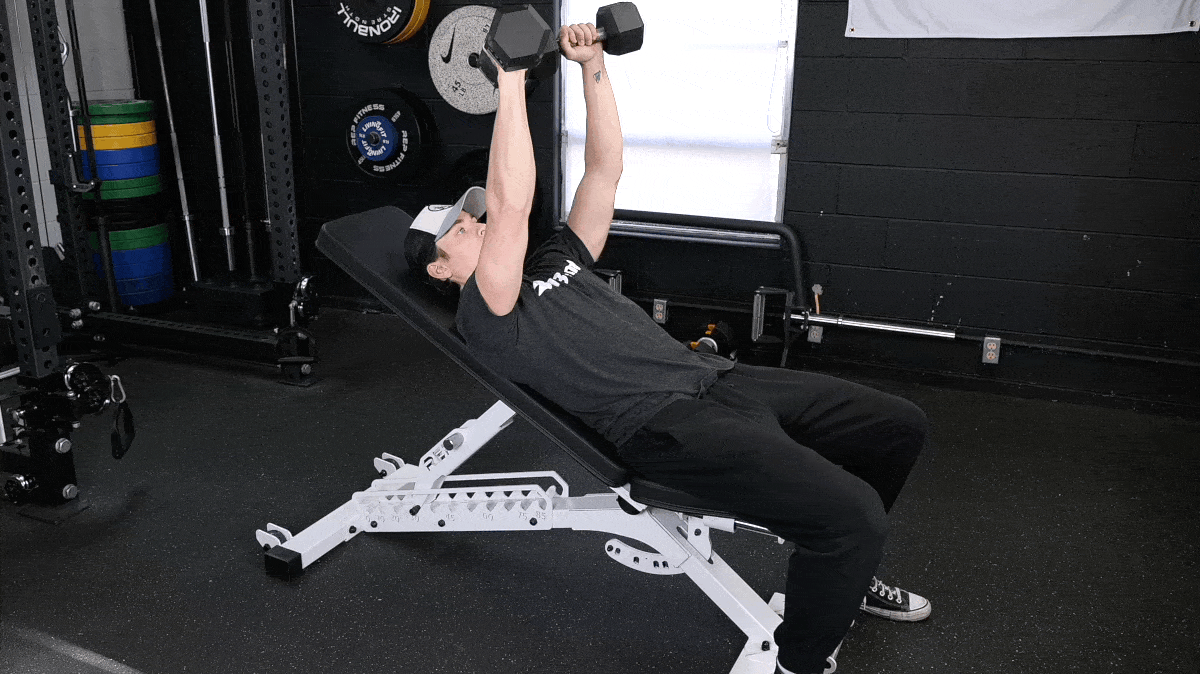
[Read More: Dumbbell Vs. Barbell Bench Press — Which is Best for Strength, Size, and Performance?]
Why Do It: For some lifters, using a barbell can force your shoulder into compromised positions. By using dumbbells, you can manipulate the weight angle, potentially avoiding issues of pain or shoulder flare-ups. This move is a unilateral exercise, great for addressing potential strength and muscle imbalances.
Equipment Needed: You’ll need an adjustable weight bench and two dumbbells.
- Set up with a dumbbell in each hand on an incline bench, angled at 30 to 45 degrees.
- With the dumbbells on your thighs (with your palms facing each other), kick your legs up one at a time to help you hoist the dumbbells into the starting position.
- Press up with that momentum and stabilize on top. Begin your set.
- Perform your desired number of reps by pushing the weight up and pulling it back down.
Single-Arm Incline Dumbbell Bench Press

Why Do It: When you’re using a single dumbbell at a time, you must control and resist spinal rotations and other rotational forces on your body. This anti-rotation emphasis increases your core’s engagement in the movement. Some lifters also find that they can truly focus on contracting the muscle as hard as possible when training single-hand pressing.
Equipment Needed: Grab an adjustable weight bench and a single dumbbell for this exercise.
- Set up for a dumbbell bench press, but with only one dumbbell.
- Brace your core and squeeze your empty fist to brace your opposite side against rotation.
- Press the single weight, keeping both shoulders on the bench.
- Alternatively, hold two dumbbells — keep one up in the “racked” position while you complete all your reps with the other arm.
Incline Barbell Bench Press Alternatives
The incline bench press is a great exercise — but you may not always have access to an adjustable bench. The alternatives below offer you many of the same muscle group training benefits, and can be great work-arounds when everyone heads for the benches on Mondays.
Flat Bench Press
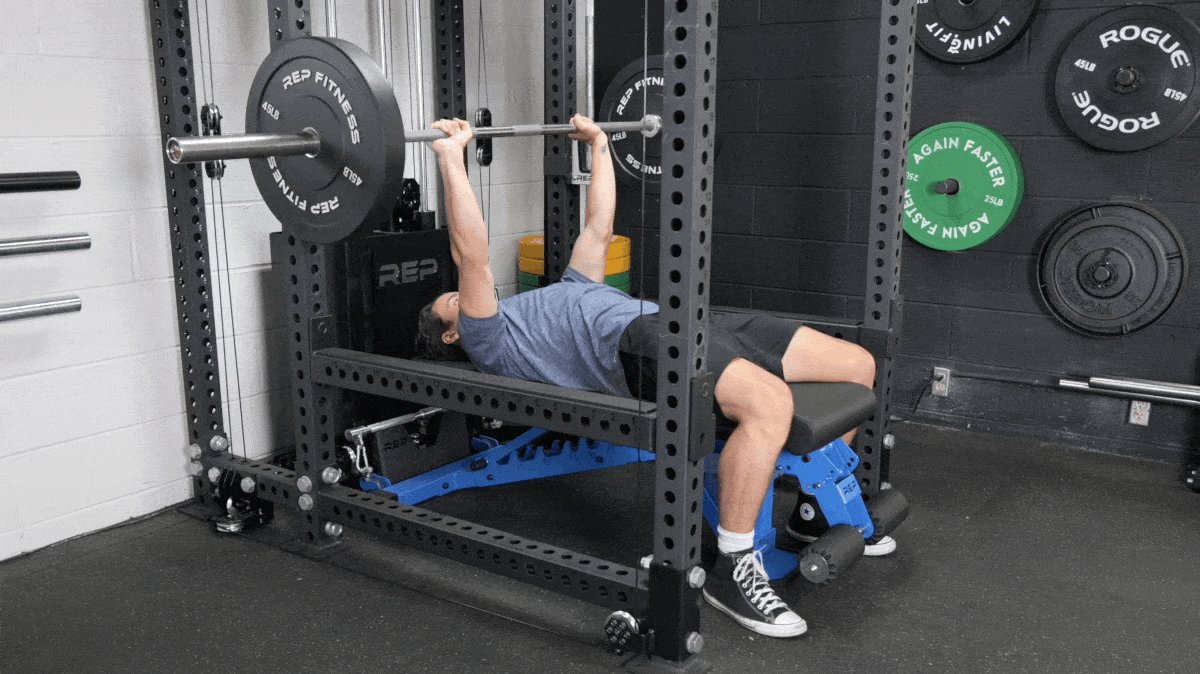
Why Do It: If you’re a powerlifter, this is your upper body’s bread and butter. The flat bench press is perhaps the most popular movement for the upper body and chest in most gyms, for powerlifters and non-powerlifters alike. You’ll build a tremendous amount of strength in your chest and even shoulders with this one.
Equipment Needed: If you’ve got access to a fully-equipped bench press station, that will be optimal. If not, set up your barbell in a squat stand or power rack. Either way, you’ll need a barbell and weight plates.
- Lie back on the bench with your eyes underneath the bar and your feed flat on the ground. Arch your back, but keep your glutes and upper back firmly on the bench.
- Inhale, then exhale and squeeze your core from all sides. Inhale again but maintain that tension and brace. Unrack the barbell and slowly pull it down to your chest.
- Briefly and gently touch the bar to your chest, then press back up. Your shoulders, elbows, and wrists should all align vertically.
- Repeat for reps.
Seated Shoulder Press
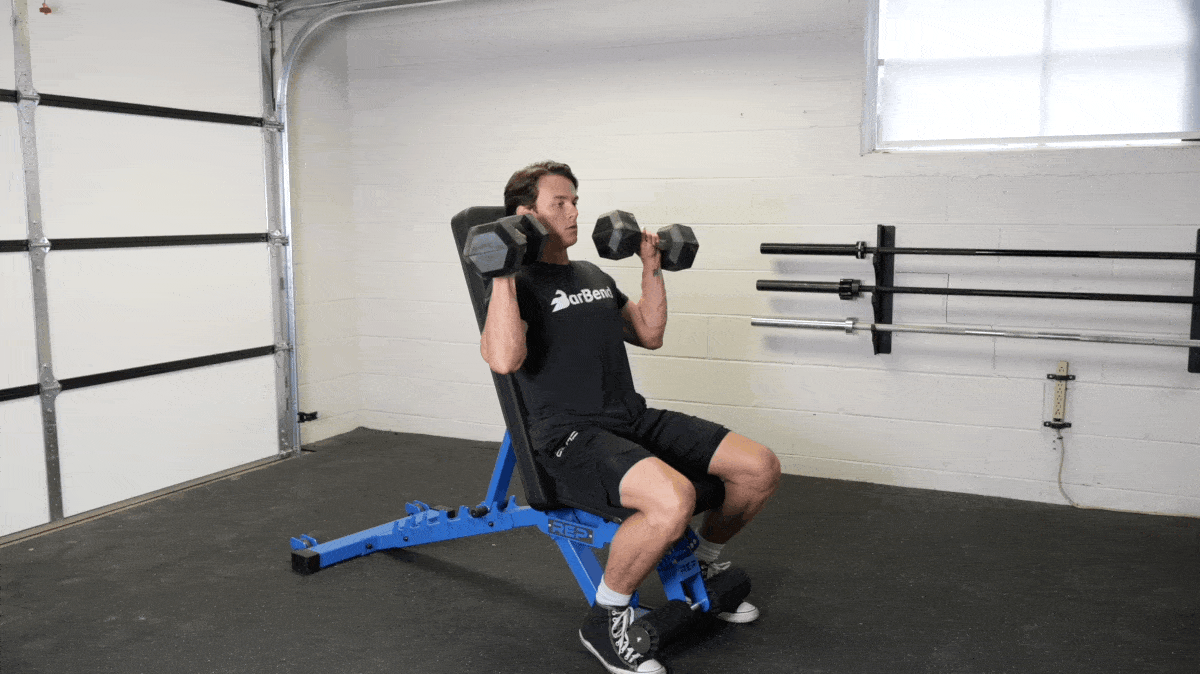
[Read More: The Only Bench Press Warm-Up You’ll Ever Need]
Why Do It: While this exercise targets your shoulders, you can customize the angle to increase the upper chest and triceps development. Decrease the angle (sit the bench up a little less straight) to shift the emphasis from your shoulders and toward your upper pecs.
Equipment Needed: Grab an adjustable weight bench and a pair of dumbbells for this.
- Adjust the weight bench to just one or two positions away from 90 degrees.
- Bring the dumbbells up to your upper chest and shoulders (roughly above your armpits), using a momentum assist from your thighs.
- Perform presses, moving the weight straight up and down.
- Repeat for reps.
Incline Close-Grip Dumbbell Bench Press
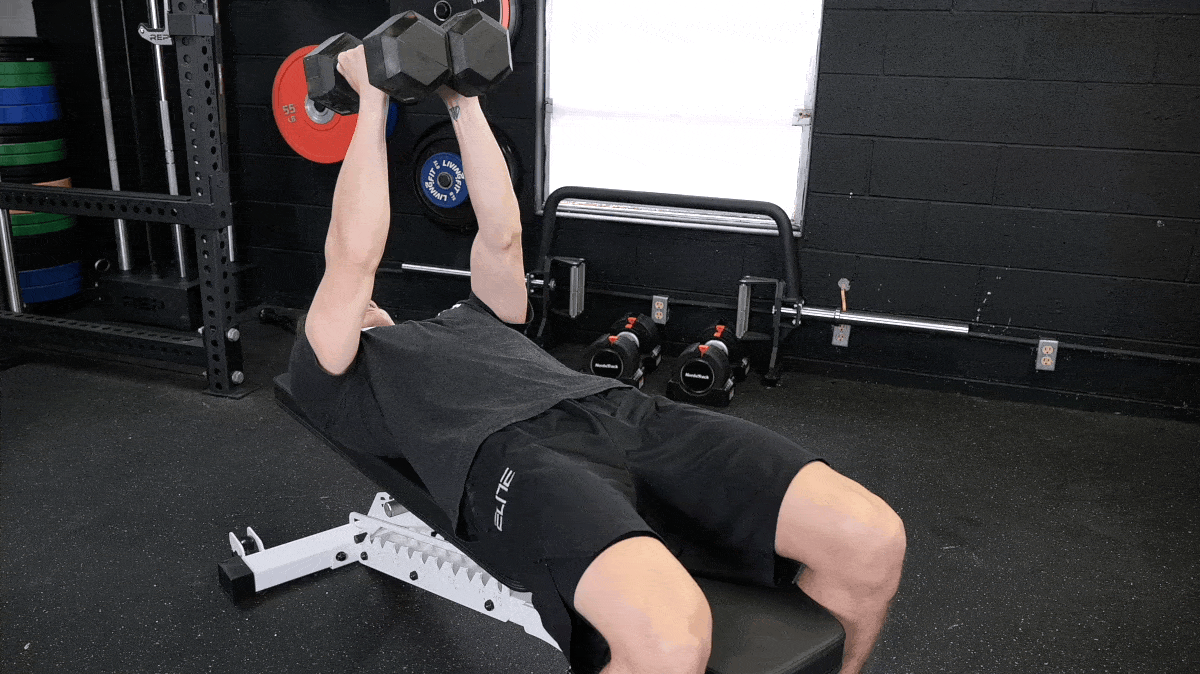
Perform the same movement on an inclined bench.
[Read More: Deciding Between the Flat, Decline, and Incline Bench Press for Your Goals]
Why Do It: The incline close-grip dumbbell bench press slightly changes the incline press into a chest and triceps-dependent movement. By keeping a close grip, you’re limiting the shoulders’ involvement. You can do this to increase upper pectoral and triceps hypertrophy and all-around pressing strength.
Equipment Needed: You’ll need an adjustable incline bench and a pair of dumbbells — preferably hex dumbbells so you can line up the sides. You can apply more force here, as opposed to circular dumbbells where they might slip around and potentially snag your fingers between them.
- Set up for a regular incline dumbbell bench press. But this time, press a pair of dumbbells together with your wrists in a neutral position (with your palms facing each other).
- As you perform your presses, keep your elbows closer to your upper body. You may not be able to come to complete the extension at the top of your reps, and that’s OK.
- Repeat for reps.
Who Should Do the Incline Barbell Bench Press
Because the incline press can increase overall pressing strength, many different lifters can benefit from including these bench press variations in their training.
- Strongman Athletes and Powerlifters: Building overall upper body mass and strength occurs through arduous training, exercise variations, and addressing all your lifting weaknesses. You can use the incline press to bridge the gap between the flat bench press and the overhead press.
- Weightlifters: Olympic lifters need to have chests, triceps, and shoulders that can produce high amounts of force to accelerate loads overhead. You also need to stabilize overhead loads, and even produce force during front rack positions and gymnastic movements. The incline bench press strengthens many of the muscles you need to accomplish those tasks.
- CrossFitters: CrossFit athletes will benefit from a stronger chest, specifically when performing burpees, gymnastic movements like dips, ring-related moves, and handstand push-ups. The incline bench can also strengthen your shoulders without adding more direct, heavy shoulder work.
- Regular Gymgoers: Most gymgoers are familiar with the bench press. But incorporating the incline bench press can help you add more weight to the bar by offering training diversity, hitting different areas of the chest, and placing less stress and strain on your shoulders when done properly.
Incline Barbell Bench Press Sets and Reps
If you are looking to incorporate the incline bench press into your workout program, you can build serious chest strength and size. You can train this lift with heavy loads and lower reps to build strength and muscle, and with more moderate loads for higher reps to build muscle.
- For Muscle: If your main goal is muscle hypertrophy, opt to want to train moderately heavy in the six to 15 rep range. Do three to five sets of five to 15 reps with moderate to heavy weight. You can also perform two to four sets of 10 to 15 reps with a moderate load until failure. Rest for 45 to 90 seconds between sets. Approach failure with each set.
- For Strength: The incline bench press can be done in a similar format as most strength lifts — using heavy loads in low to moderate rep ranges for maximum strength gains. You’ll want to take longer rest times when taking this approach. Do three sets of five sets of three to five reps with a heavy weight. Rest three to five minutes between sets.
Benefits of the Incline Barbell Bench Press
The incline barbell bench press is a slight variation of the traditional bench press. It offers many of the same benefits — more muscle and strength — as well as targeted muscle growth of the upper chest. You’ll find more details below.
Add More Upper Body Muscle
You can train the incline bench press with relatively heavy loads and high volume. This makes it a very effective multi-joint, compound lift for maximizing muscle growth.
[Read More: Incline Bench Press vs. Flat Bench Press: Which One Builds Your Pecs Better?]
You can use the sets and reps, and weights guidelines below to individualize strength and hypertrophy programs to best suit your needs.
Isolate the Upper Chest More
Any kind of bench press targets the pectoral muscles, regardless of whether you’re lying flat, on a decline, or on an incline. However, the incline bench press can isolate the upper pec fibers to a greater extent due to your body’s angle. This makes it a great move for developing weaker ranges and potentially neglected aspects of the chest.
Increase Upper Body Pressing Strength and Athletic Performance
Athletes can use the incline bench press to diversify their pressing strength and performance. By switching up the angles of pressing variations, athletes can often target sticking points, address muscle weaknesses, and stimulate new muscle growth.
Incline Barbell Bench Press Muscles Worked
The incline bench press mainly focuses on the chest, but it’s not an isolation exercise. The muscles that are used during the incline bench press are the larger muscle groups of the upper body. Increasing size and strength of these muscles can have great carryover to other pressing movements.
- Pectorals (Chest): The chest muscles are worked during all bench pressing movements. However, the incline press does place higher demands on the upper chest muscles due to the press’s increased angle in the press.
- Front (Anterior) Deltoids: In the bench press, the front deltoids are active. In the incline press, however, the front delts are involved to an even greater extent. As you assume a more vertical pressing plane, you’ll target your upper chest and anterior deltoids. The more vertical your press angle is, the more you involve your shoulders.
- Triceps: Your triceps work to extend your elbow in the top part of the bench press. These muscles work similarly during the incline bench press. In that way, this move can diversify triceps pressing strength, which ultimately will help your presses all around.
Common Incline Barbell Bench Press Mistakes
In some senses, this is a straightforward lift. But that doesn’t mean it’s not easy to slip up. Here’s how to avoid the most frequent errors we see.
Using the Wrong Incline
You’ll want to use the right incline here. For a lot of lifters, that means setting up your bench somewhere between 30 and 45 degrees, angle-wise. But everyone has different limb lengths, which can really make a difference.
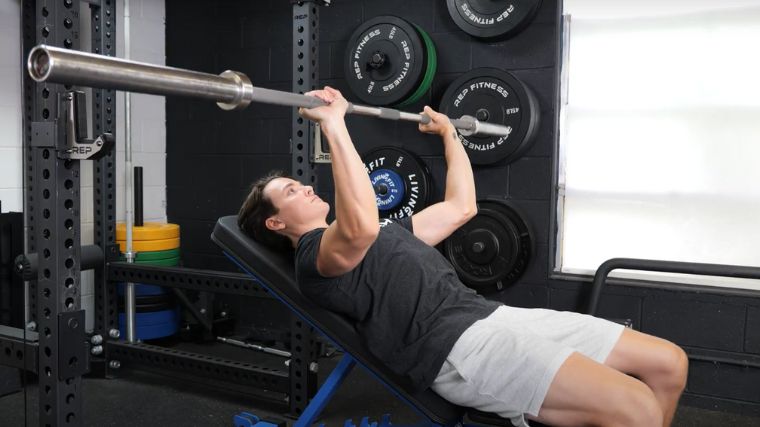
[Read More: The Best Bench Press Workouts for Your Experience Level]
To find the right incline angle for your incline bench press, do a few practice lifts with an empty barbell. Can you feel your chest activating, specifically in your upper chest area? Or are you mostly feeling the move in your delts (shoulders)? If you’re feeling it in your shoulders primarily, you likely are at too high of an incline. Make the bench a little bit more horizontal and try again.
Bouncing the Weight
It’s tempting with any type of bench press to bounce the bar off your chest at the bottom of each rep. We get it — you can typically lift a lot more weight that way. And while there’s a time and a place for bouncing your reps, you’ll usually get the most bang for your buck by bringing the bar to a brief, full stop on your chest.
[Read More: 5 Bench Press Programs to Build a Bigger, Stronger Chest]
Imagine that your phone is on your chest, right where the bar is going to come down. The idea is to tap your chest lightly and hold — in this visualization, so you don’t bounce off and break the screen of the imaginary phone.
Going Too Heavy
Just because you can slide a few hefty plates onto your flat bench press doesn’t mean you’ll be able to do the same here. At least not right away. The flat bench press and the incline bench press are indeed close cousins, but they are not the same lift. Start significantly lower than your flat bench press — try 65 to 75 percent of your typical working weight (on the lower end if you’re just starting) — and build up from there.
Incline Your Presses
The incline bench press can help you build a bigger, broader chest, stronger pressing, and help diversify your upper body pressing training. You’ll train this move similar to how you train heavier bench press options.
But this exercise also allows you to train in a slightly higher rep range to really drive muscle growth. Like the flat bench press, the incline bench press is a great addition to any upper body training program.
FAQs
You’re ready to get pumping with the incline barbell bench press, but you’ve still got some questions. So, here are some more answers to common questions we get about the incline bench press.
Can I do the incline bench press as my main chest exercise?
Sure. The flat bench press isn’t the end-all-be-all move for your chest. If the incline bench press feels good to you, and you like the added shoulder activation, then stick with the incline bench. That said, if you’re a powerlifter, then you need to do the flat bench, as it’s a competition lift.
Should I start or end my chest workout with the incline bench press?
It depends on how you’re using it. For more muscle mass or endurance, which require higher rep sets, do them later in your workout. Since you’re using lighter weight, it won’t matter if your muscles are fatigued. However, if you’re trying to press heavier weight for strength, lead with the incline bench press.
How do I progress my incline bench press?
Progress this lift the same way you progress any lift. Employ a gradual strategy of progressive overload, be patient, and stick to your plan.
Which is better: the barbell versus dumbbell incline bench press?
In strength sports, “better” is pretty much always a function of what you want to accomplish. If you’re aiming to take it easier on your shoulders, the dumbbell incline bench press is often a better bet. Ditto if you’re trying to work on your unilateral training and adjust for any strength or muscle imbalances. But if you’re looking to lift the most weight you can at this angle, the barbell reigns supreme.
Featured Image: ARENA Creative / Shutterstock